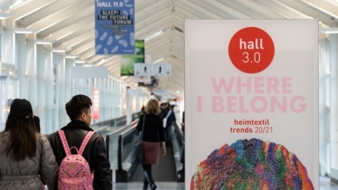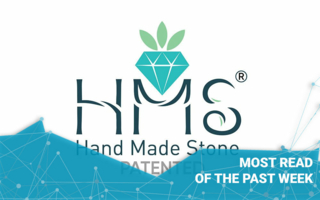19/02/2020 – Sustainability and high value — auf Deutsch lesen
The issues of the future dominated at Heimtextil 2020
The sustainability was a central thread that ran through the entire event at Heimtextil 2020. Change is gaining momentum!
Extensive activities and informative displays demonstrated how material processes are changing all over the world, with a view to improving the environment, and how social responsibility in respect of the people employed in the industry is growing. Even if the figures still do not add up, and preparedness of consumers to spend more money for environmentally friendly textiles is still in its infancy, supply and demand at the world’s largest trade fair for home and contract textiles were larger than ever before. Durability and a second life are beginning to manifest themselves in products.
Martin Auerbach, General Manager of the Association of the German Home Textile Industry (Verband der Deutschen Heimtextilien-Industrie e.V.):
“The re-think is really only just beginning, because to actually get to the circular economy, we must think and act with the entire value creation chain in mind. And moreover: up to now the product was the most important thing in the development phase. To achieve the transition to the circular economy, we need to formulate things the other way around. So, the questions become: What would the product that is optimised for economic circularity look like? How can we then achieve the required functionalities? And finally: How will manufacturers be able to differentiate themselves from the competition in the marketplace with their products?”
Long-term thinking has a future
As far as the visitors were concerned, the considerable interest in sustainable concepts was also in evidence in the newly instituted ‘Future Materials Library’ in the ‘Trend Space’ in Hall 3.0. The Library offered some exciting insights into innovations in sustainably produced textiles. The section on ‘Natural Assets’ drew attention to some hitherto unused natural treasures in the form of algae and stinging nettles, as did ‘Living Materials’ to cultured materials from a mesh of growing fungal fibres and ‘Biological Byproducts’ to agricultural resources in the form of orange peel and agave leaves. Then again ‘Remade’ demonstrated the potential for re-use inherent in textile waste material.
The unifying concept is ‘diversity’
The question of trends for 2020 is, it seems, not at all easy to answer. The age of fixed stylistic currents, determined in advance, is over. Mass taste no longer exists. It is all about diversity. This was given impressive and abundant expression in the lavishly staged Trend Space in Hall 3.0, with no fewer than 1,000 exhibits. The display for the topic ‘Where I belong’ illustrated that identity is formed as a result of many experiences. And these, in turn, have something to do with the way one furnishes one’s environment and what one likes. It is all about inclusion, getting together, chatting. The single main aim: a sense of well-being. And it is about using textiles in interior designs to create a cosy, pleasant atmosphere. And that may well look different for each of us.
Commercial and contract textiles
The appeal for visitors of the commercial and contract textiles in the new ‘Interior.Architecture.Hospitality Library’ lay, above all, in their functional qualities. The textile materials library, which was on display for the first time, demonstrated the spectrum of modern functional textiles by means of a carefully curated selection of Heimtextil exhibits. These included ‘Sensation’, a flame-retardant velvet (Edmund Bell), as well as Solarflex, a twill with sound-absorbing properties (A House of Happiness – Royal Vriesco), ‘Vogue’, a water-repellent, textured wallpaper (Omexco) and ‘Soft Basic’, a hard-wearing velvet, (Gebr. Munzert). Altogether, the library contained 64 textiles grouped in four functional categories (hard-wearing, sound-absorbing, flame-retardant, and water-repellent). HERE the library can be accessed online throughout the year and offers a valuable tool when selecting contract and commercial textiles.
The Expo, held in Hall 4.2
The Expo, held in Hall 4.2, showcased a selection of textile products and furnishing solutions for commercial and contract situations. Exhibiting there, too, were Féline, a start-up from the Netherlands with sustainable and highly flexible acoustic solutions made from wool felt. With their product, which goes by the name of ‘minimal art collection’, this newcomer to the market won the coveted ‘Heimtextil Trendscouting by AIT’ award.
Renske Vogel, Founder and Managing Partner of Féline:
“Many customers are unaware of just how damaging to the environment traditional felt manufacture is. We did a lot of research before we started and took our time over the development. Now, with our Féline Fresco Collection, we can offer a genuinely sustainable and very modern alternative.”
Initially, some 50 interior architects, planners and hotel specialists nominated the leading trend setters from amongst the exhibits at Heimtextil for the ‘Heimtextil Trendscouting by AIT’ award. On the second day of the trade fair, a distinguished jury of experts finally chose the ‘Heimtextil Trendscouting by AIT’ winner and three special mentions (the flax-based wallpaper by Norafin Industries / Extra Organic, the OceanSafe principle and the Square LED from Marburger Tapetenfabrik).
The new consumers are what make the difference
Companies are increasingly coming to see the sustainability issue as an opportunity. Even the number of the companies attending Heimtextil 2020 with sustainable operations was, at 259, higher than ever before. All these exhibitors had signed up for the Green Directory and its certification. Sustainable production and sustainable company behaviours are becoming a constant and reveal themselves in numerous areas at Heimtextil: self-adhesive decorative and functional films, designed to give furniture and walls a ‘second life’ (Konrad Hornschuch), the use of compostable materials (Alonso Mercader), traditional wovens from upcycled yarn (The Aviary Studio), one hundred percent recyclable wallcoverings, coupled with decorative and FSC-certificated ones with gleaming digital prints (Komar Products). The Spanish firm of Antex launched its sustainable products as long ago as 2007, but demand has increased in the last two to three years: “The new consumer is what is making the difference.”
Ecological production
The future of the textile industry, which has a huge impact on the environment, was also abundantly in evidence in the ‘Textile Technology’ section. That sustainability can be combined with further development is clear in the early, technical stages. Alongside automation, it is digitalisation, above all, that offers so many new possibilities. That includes printing machines, which not only reduce consumption of energy and water, but are also quicker and work with water-based inks containing eco-certified pigments (KIIAN Digital/JK Group). Super-soluble, intensely pigmented dyes for digital printing save up to 35 percent energy per kilo of fabric and up to 30 litres of water, because washing and steaming processes are omitted (Itaca Textile). A new paper for transfer printing that, because of a special coating, requires no preparation or secondary treatment, makes for both speed and improved print quality (Neenah Coldenhove).
Taken from the world of fashion
The recourse to glamorous ages past also brings to interiors patterns for curtains and furniture that range from the bold to the playful and are taken from the world of fashion (Pala Suni Deri). Patterns and motifs emerge, that also find application in the fashion, furnishing and lifestyle markets (Pattern Hive, Studio Bodhi). Rooms are dressed in the manner of haute couture (Karin Sajo/Grandeco Wallfashion Group). Original artwork (Sooshichacha) or sophisticated, woven fabric images are used for cushions and curtains (Woven Art Company). The patterning’s artistic side comes to the fore. Cushions with abstract faces in the style of Picasso (Alfred Apelt, Gardisette) are also part of this current and convey a touch of artistic sophistication. In addition, we find prints for wallpaper that use water colour techniques (Eijffinger) and are even created as unique pieces in cooperation with artists (Feathr Oy).
The next Heimtextil will take place from 12 to 15 January 2021.




